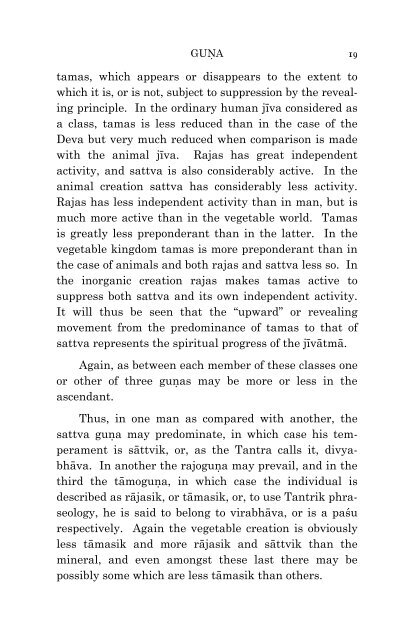Introduction to Tantra Sastra - Aghori
Introduction to Tantra Sastra - Aghori
Introduction to Tantra Sastra - Aghori
Create successful ePaper yourself
Turn your PDF publications into a flip-book with our unique Google optimized e-Paper software.
GU Ṇ A 19<br />
tamas, which appears or disappears <strong>to</strong> the extent <strong>to</strong><br />
which it is, or is not, subject <strong>to</strong> suppression by the revealing<br />
principle. In the ordinary human jīva considered as<br />
a class, tamas is less reduced than in the case of the<br />
Deva but very much reduced when comparison is made<br />
with the animal jīva. Rajas has great independent<br />
activity, and sattva is also considerably active. In the<br />
animal creation sattva has considerably less activity.<br />
Rajas has less independent activity than in man, but is<br />
much more active than in the vegetable world. Tamas<br />
is greatly less preponderant than in the latter. In the<br />
vegetable kingdom tamas is more preponderant than in<br />
the case of animals and both rajas and sattva less so. In<br />
the inorganic creation rajas makes tamas active <strong>to</strong><br />
suppress both sattva and its own independent activity.<br />
It will thus be seen that the “upward” or revealing<br />
movement from the predominance of tamas <strong>to</strong> that of<br />
sattva represents the spiritual progress of the jīvātmā.<br />
Again, as between each member of these classes one<br />
or other of three guṇ as may be more or less in the<br />
ascendant.<br />
Thus, in one man as compared with another, the<br />
sattva guṇ a may predominate, in which case his temperament<br />
is sāttvik, or, as the <strong>Tantra</strong> calls it, divyabhāva.<br />
In another the rajoguṇ a may prevail, and in the<br />
third the tāmoguṇ a, in which case the individual is<br />
described as rājasik, or tāmasik, or, <strong>to</strong> use Tantrik phraseology,<br />
he is said <strong>to</strong> belong <strong>to</strong> virabhāva, or is a paśu<br />
respectively. Again the vegetable creation is obviously<br />
less tāmasik and more rājasik and sāttvik than the<br />
mineral, and even amongst these last there may be<br />
possibly some which are less tāmasik than others.

















